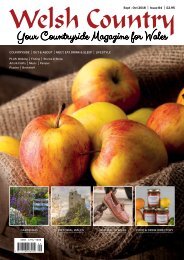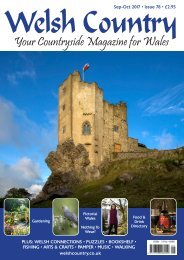Welsh Country March-April 2017
Create successful ePaper yourself
Turn your PDF publications into a flip-book with our unique Google optimized e-Paper software.
FISHING<br />
Changes made to<br />
Rod Licensing<br />
Anthony Rees discusses the new Rod<br />
Licence Structure and the devastating news<br />
of pollution in the River Teifi<br />
As I write this the New Year is upon us and anglers are<br />
already inquiring about memberships of clubs around<br />
Wales for <strong>2017</strong>.<br />
The New Rod Licence Structure has now been accepted and<br />
approved by the <strong>Welsh</strong> Assembly Government. There are changes<br />
in Rod Licence duty for the coming season 1 st <strong>April</strong> <strong>2017</strong>. A yearly<br />
licence will now last 365 days from when it was purchased. This is<br />
a very helpful change, particularly when a person takes up fishing<br />
mid-season. Young fishers (17 and under) will not have to pay, but<br />
must apply for a free one. This is to encourage more youngsters<br />
into the art of angling. Some of the costs of this free licence will<br />
be borne by increases in prices for adult licences, so a full Trout<br />
and Coarse licence costs £30, (£20 concessionary, £12 week, £6<br />
day) and a Migratory fish licence costs £82 (£54 concessionary,<br />
£27 week, £12 day). I would suggest unless you are fishing very<br />
occasionally that you buy a full rod licence. Also be careful as the<br />
new structure does not start until 1 st <strong>April</strong> <strong>2017</strong>, before this you will<br />
have to buy at 2016 prices.<br />
The River Wye has recorded the best salmon catch for many<br />
years with a final total in excess of 1,670 fish. The Usk has also had<br />
a good year with a predicted catch of 800 fish. We need consistent<br />
steady flows to allow salmon to run our rivers and the Wye Usk<br />
Foundation has done much working with <strong>Welsh</strong> Water to achieve<br />
these consistent flows that allow the salmon to run up river. But as<br />
important is the right flow to help the smolts when they run back<br />
to sea in <strong>April</strong>/May.<br />
My report in Nov/Dec mentioned the lack of young salmon<br />
being found in electro fishing surveys in some streams in Wales. At<br />
this time there is still no clear indication of what may have caused<br />
the problem. We do know however that many problems face the<br />
salmon and once again new rounds of restrictions on methods,<br />
baits and seasons are being looked at. Anglers are again the target<br />
of these restrictions even though it has been agreed they are not<br />
the cause of the decline. There is much opposition to the proposals<br />
around Wales.<br />
Early season Trout fishing on many rivers will follow the pattern<br />
we see on the Rivers Taff and Usk. It can be very unpredictable<br />
and is highly dependent on river and weather conditions.<br />
Inexperienced or novice anglers are often of the opinion that<br />
warmer weather is required to encourage fly hatches, but this is not<br />
the case.<br />
The large Dark Olive is the only fly the angler is likely to<br />
encounter in any numbers on most rivers and this species is a cold<br />
weather fly. Settled sunny and unseasonably warm weather will<br />
usually curtail activity. Cold dismal and blustery conditions on the<br />
other hand will usually see far better hatches. Indeed, some of the<br />
best hatches can occur on the coldest of days. It is the angler who is<br />
prepared to brave the elements who will enjoy the best of the early<br />
season fishing on offer.<br />
From mid-<strong>March</strong> to mid-<strong>April</strong> anglers fishing the Usk may<br />
encounter the <strong>March</strong> Brown, numbers of which have increased<br />
considerably in recent years following significant losses since the<br />
late 1990’s. Once again, the cold and unsettled weather will see<br />
better hatches of these as well. When either species is hatching<br />
fish will often ignore a dun floating on the surface and prefer to<br />
select the emerging nymph in the process of hatching. An emerger<br />
pattern with some of the dressing sub surface will usually be more<br />
effective than a “dry’’ one.<br />
Some of the modern C.D.C patterns achieve this very well as<br />
do more traditional parachute style flies, tied on either straight<br />
or curved shank hooks. On some days fish will readily take a wet<br />
fly and some of the traditional wet patterns such as Blue Upright,<br />
Greenwell’s Glory, Water Hen Bloa, and Gold Ribbed Hare Ear,<br />
have not been improved on over the years when using this tactic. If<br />
the <strong>March</strong> Brown is present then a wet style pattern will suffice or<br />
a deadly alternative the Partridge and Orange can be added to the<br />
list.<br />
At the time of writing the river Teifi has been subjected to a<br />
devastating pollution reported as being from a major discharge of<br />
farm slurry. This and the runoff from fields, due to the planting<br />
of some crops on or near the river that contribute to soil erosion,<br />
is one of the major problems facing a healthy river eco system. It<br />
needs central Government, in our case the <strong>Welsh</strong> Assembly to act<br />
firmly and in a positive manner with legislation if necessary to<br />
control this problem. U<br />
Words: Anthony Rees<br />
Picture: Daniel Gardiner<br />
Brown Trout Caught River Taff Sept 2016<br />
www.welshcountry.co.uk 9




